David Caldwell Reed
1809—ca. 1879
Founder of Reedsburg, Wisconsin







“He was a tall, slender gentleman with graying hair, very pleasant looking, and with always a twinkle in his blue eyes, always jolly and friendly.” Adescription of David Caldwell Reed fromA Portrait in Words by Mrs. Eliza Reed (a first cousin of David Reed), wife of George Hamilton Irwin.
Compiled by William C. Schuette
Copyright 2024


Joseph Mackey, an early settler, wrote that “In 1847 a person, whose name to me is now unknown, came up to Sauk County, discovered the iron mines and returned to Big Foot Prairie where he was taken sick and died. Prior to his death he communicated to David C. Reed his discovery. Reed immediately packed his belongings and headed for the new settlement. He laid claim to two hundred acres, which included the iron mines, along with the southwest quarter of section l0, T. 12N, R-1E. which is located south of Main street. The land next to the Baraboo River was marshy and “trembled beneath the feet, whenever walked upon.” However. Mr. Reed foresaw a great city being built on the site and was not dissuaded. Reed in company with a Mr. Powell, also laid claim to the land upon which the mill power stands. In June, 1847, the first improvements were commenced the construction of a dam and the building of a shanty for the accommodation of the men engaged in the work.”
It seems likely that Mr. David Reed and Mr. Aaron Powell did not complete a great deal of the shanty -building until the next spring. It is likely that they got up a rude shelter for themselves, worked on the dam, made a beginning on “Shanty Row” and then went back to Walworth county for the winter.
The famous “Shanty Row” consisted of five rude log structures, built down the center of what is today Main Street. The cabins were made from tamarack poles which Reed and Powell “appropriated” from

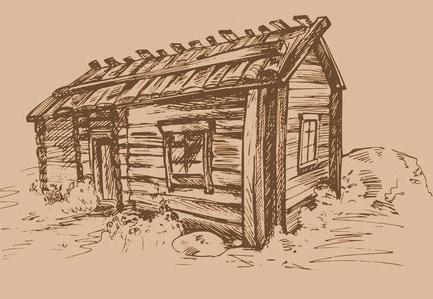

the river as they floated past. The logs had been harvested by George and Edward Willard, upstream and were being floated down the river to their sawmill at Baraboo.
The shanties were hastily constructed, the cracks between the logs being chinked up with swamp mud; the roofs being made of bark slabs. Uncomfortable to say the least, the roofs leaked profusely during rainstorms, necessitating the use of umbrellas. The doors were made of basswood and would swell too large for their openings during damp weather.

It was noted at the time that the land along the river was so marshy that one could actually catch sunfish where the Big Store Plaza is now located. “Shanty Row faced a mire in which many a person was often to have been caught and been compelled to measure his length in a pleasant plaster of mud,” recalled an early settler.
From the 1880 History of Sauk County, we learn that: “The first load of goods brought into Reedsburg consisted of two barrels of whiskey, one barrel of pork, and a few minor sundries. The wagon containing it took the lead, the advance courier of the little band of pioneers who arrived a few hours later and took temporary residence in ‘Shanty Row’ constructed the previous season by Messrs. Reed and Powell.”

It has been noted by early settlers of Reedsburg that the main street was swampy and muddy. There is evidence in the above ca. 1870s etching, that along the sides of the thoroughfare there were deep ditches filled with water. Planks can be seen on the right and left sides of the road which cross the ditches providing people access to the stores. The ditches also drained the main street after a rainstorm.
“Shanty Row faced a mire in which many a person was often to have been caught and been compelled to measure his length in a pleasant plaster of mud,” recalled an early settler.
The land next to the Baraboo River was marshy and “trembled beneath the feet, whenever walked upon.” However. Mr. Reed foresaw a great city being built on the site and was not dissuaded.
The first shanty, located at the west end of the row, near the river, was known as “Bachelors’ Hall.” “It was here that the boys came together in the evening to discuss the day’s activities. This ended with each joining in devotions conducted by Elder Locket a man who knew his Bible. Then each would retire to his respective place of abode.”
Bachelors’ Hall was occupied as a sleeping room with berths one above the other, steamboat style, noted Rev. Dwinnell, and it had an outside stone chimney, “so poorly made that much of the smoke found its way into the room and rendered its occupants quite uncomfortable.”
The second shanty was used as a storeroom. “It was in the shanty that was the storehouse that the devil in the form of intemperance first developed.” Someone, (probably Rev. Dwinnell) under the heading “Temperance”, says in the 1880 History of Sauk County, “…but it must not be understood that the occupants of the shanties were intemperate; just the reverse. Of course, a few of the men imbibed a little, but the majority of the community abhorred the name of whiskey, and the duty of consuming the two barrels fell to the Indians who were employed to assist in the building of the dam, being paid in “firewater.” (And it was sometimes watered down.)
The other three cabins were occupied by Mr. Powell and his family, William McClung (a millwright), his wife and daughter. Elder Alexander Locke, his wife and six children.
Dennis Clossey came into the area in the fall, 1847. His obituary in the Free Press of December 11, 1894 notes, “...On October 12, l847, he (Mr. Clossey) arrived at the site of Reedsburg. There was no bridge across the river. He waded the ford just below the present dam, with an ox team drawing his family. He built a shanty where W. P. Dennett's residence now is and lived there until he constructed a house on the farm (near Ironton) where he afterwards lived until he died.” His shanty stood on the west side of the river, across the street east from the present location of the Reedsburg Community Church of the Nazarene (former United Brethren Church). This was the first family residence put up at the site of our present city.”
In the spring of 1848 the new building was done (started in 1847, with more work done in 1848);
“Two apartments were erected under one roof; two rooms, twelve by sixteen feet were built twelve feet apart, tamarack poles of sufficient length to reach across both structures being placed on top, thus forming a covered compartment between the two. (It seems to have been patterned after the one built by Mr. Babb on his prairie. This construction was known as “Dog trot construction.”) See photo below.

The roof was made of elm bark, peeled horizontally from adjacent trees and used in the same manner as shingles, two tiers of bark being sufficient to cover one side of the shanty. The cracks in the shanties were chinked and daubed with pieces of threecornered wood and a liberal proportion of the native swamp mud which, in soft weather, existed in generous quantities; and when this composition of bog and basswood dried, there was no necessity for windows for the purpose of light and ventilation.”
In June, 1848, just a month after Wisconsin became the 30th state in the Union, the frame of a sawmill was put up at Reedsburg. John H. Rork put up a log house in August a half mile east of the mill-site, expecting to bring his family up from Racine that fall. In one of the shanties, just north of the Indian knoll graves, the first poll was opened in the autumn of 1848. The new voting precinct was called “Baraboo.”


It consisted of all the present towns of Woodland, LaValle, Winfield, Dellona, Excelsior, and parts of Reedsburg and Ironton. People living in “Shanty Row” (besides the ones already mentioned) were Mr. and Mrs. Volney Spink, Rev. Saxby and daughter, Amanda, a Mr. Brace living with the Powells, Keyes Bishop and Dennis Bishop. The last mentioned “helped to erect the first log cabin which marked the beginning of Reedsburg in 1848,” according to his obituary, printed in the Free Press of Sept. 17,1908. In the secretary’s Book of the Reedsburg Old Settlers’ Association 1877, W.W. Rork has written, “Dennis Bishop who played for the first dance in Reedsburg in the Saw Mill was called to play on the same violin which 28 years ago reverberated for the early Reedsburgers to trip the light fantastic toe.” And in this same book in which the old settlers wrote their names, and put down the date of their settlement here, maybe found the signature:
DENNIS BISHOP, April, 1848. Rev. S. A. Dwinnell tells of coming to Reedsburg in October, 1848: “...In the afternoon we reached Baraboo (the Rapids), put up with Col. Sumner (in a 2-story hotel at the northeast comer of the public square) where we unexpectedly found a company of four who had arrived there the evening previous, from the same town in which we lived in Walworth County. Soon after our arrival the heavy rain began which continued until 9 A. M. Saturday. As we learned that a man by the name of David C. Reed was building a mill and founding a village on the river 16 miles above, we resolved to proceed thither. After leaving Lyons (West Baraboo), there was no house on the way except the board shanty of Thompson Shephard on Copper Creek. “In what is now Reedsburg, we found the frame of a saw-mill, and five log shanties which stood in what is now Main Street, just in front of Reinecke’s Hotel and Roper’s Eating House.
“On Sunday our company engaged Mr. Reed to go with them to look for Land, on the plea of necessity that he could not leave his work to go on a weekday. I told him that I was not (intending to go that day) that I was intending to come here to settle and was coming with clean hands, so that I could reprove the people for Sabbath breaking and other wrong-doing. He laughingly replied that they were not going to break the Sabbath but only intended to bend it a little.
In the evening 29 persons assembled in Mr. Powell's cabin, when Elder Locke offered prayer and I gave a lecture upon the law. David Reed took [the men] of my party and the other nearly ten miles from home before he showed them any vacant land. They made claims on three quarter sections that day, two of them very good ones...at that time there was not a family settled in the present towns of Westfield, Washington, Woodland, or Winfield.” On a later day Mr. Dwinnell told Mr. Reed that he wished to hire his services for a day to show him land, and Mr. Reed did so: “The first 1/4 section he showed me as vacant land was the one upon which I now live." (Section 10, Reedsburg). “He said that his millwright had claimed one 80 of it, and he had promised to enter it for him, but had been disappointed in respect to money to do it; that if I would enter it and give him one 40, that it would be satisfactory. In the course of the afternoon, Mr. Reed gave me an interesting account of his life and remarked with special reference to the manner in which he had spent the preceding Sabbath ‘I (David Reed) was brought up by a Baptist minister and well instructed by him and his wife. After I was married and they became superannuated [incapacitated by advanced age], I took them home and cared for them as long as they lived. I know my duty better than I do it.’” Joe Green came to Reedsburg in December, 1848 and worked for Mr. Reed. The winter of 1848-49 was a bad one, and “starving time” for the few settlers.
In January, 1849, Austin Seeley and his family arrived. Mr. Seeley had known David Reed in Walworth County, and at his inducement came up to the mill site. He was very discouraged when he reached the place, offered the man who had brought them his last $3 to take them back to Baraboo, where they had friends. The man required $4, and as Mr. Seeley did not have it, they were obliged to stay.
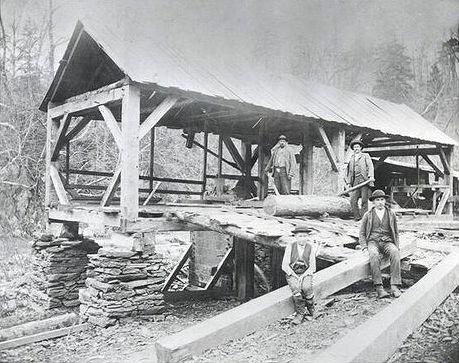

The Seeley family built a shanty, later known as the “Mill House” because of its proximity to the sawmill. Seeley worked at the mill only four days when he accidently cut off his thumb. So, the job of shingling their newly constructed cabin fell to Mrs. Seeley, who, by default became the city’s first carpenter. In 1875, Mr. Seeley was a gunsmith with a shop on Main street.
The John W. Rork family came in February, 1849, having been delayed in their start by the illness of their son, Ruben. They found the residents of shanty row in a state of destitution. The only food left in the whole community was a shank of venison. The Rork’s had rather more than the usual amount of provisions with them and shared with the occupants of the other shanties, until all were down to subsisting on a few frozen potatoes and a haunch of venison. The nearest places where food might be obtained were Portage or Madison; however, there was neither the time nor the means to haul provisions to the starving settlers.
In May, 1849, Alanson Reed, a cousin of David’s, arrived with his family.
The obituary of George Boganrief, Free Press of March 13,1902, tells of his early visit to Reedsburg: “In April, 1848, with one horse and wagon, a wife and four children, he started West. From Pennsylvania, landed in Beloit, Wis., ran the first railroad engine out of Chicago in 1848.
In 1849 he and two others made a trip from Madison to Reedsburg. They spent two days in the woods between Baraboo and Reedsburg with nothing to eat and when they arrived at Reedsburg found only 3 or 4 shanties with the people poorly supplied. Before leaving, he and his two companions assisted in placing of the first log on the carriage of Reed and Powell’s saw-mill.
Reed wanted the little settlement to grow and to prosper. To facilitate that end, he presented land for a public square and donated land for the first burying ground (now part of the city it was located to the north of the Pine and 6th street school lot).
There had been no births in the place for nearly two years, so Reed conceived of a plan to boost the population. He offered a free lot to the first woman of the hamlet who had a baby. Mrs. Seeley secured
an orphan through a friend at Baraboo, claimed the lot, but was told that it had to be a “native-born” baby.
At the southwest corner of the public square in City Park, is a boulder of granite, with a marker attached, put up by the Reedsburg Old Settlers Association in 1944, It reads: “In memory of D.C. Reed who founded this city in 1847 and later donated this park - Placed by Reedsburg Old Settlers Association.”
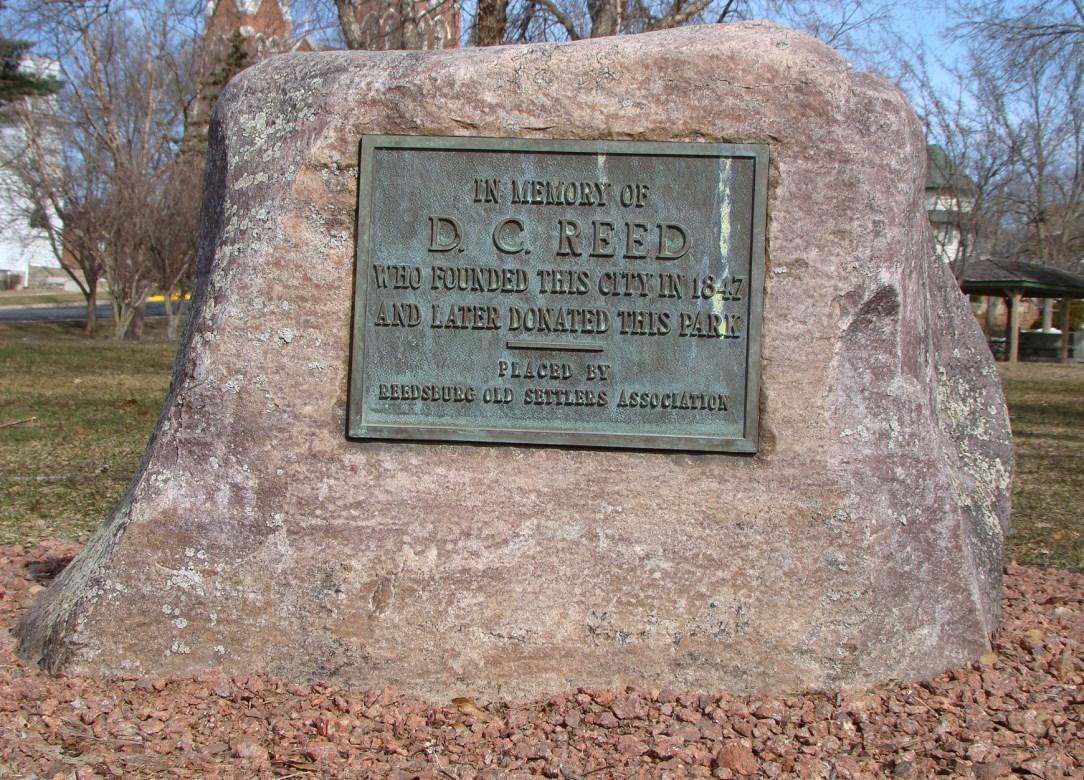



Reedsburg Free Press
August 29, 1878
The site upon which the village, and eventually the city of Reedsburg would soon be built, was a tamarack swamp beside the Baraboo River when Don C. Barry and Henry Perry first set eyes upon it in 1844. They were the first white settlers to explore the territory and were looking for a place to set up a lumbering operation. However, they were sidetracked when they discovered traces of copper in what is now the township of Reedsburg. By 1847, other settlers were trickling into the community and one David C. Reed realized the opportunities that the shallow, stonelined section of the Baraboo River offered for the construction of a dam to provide power to turn a saw -blade. He immediately purchased the lot, along with much of the land upon which present day Reedsburg stands, and commenced construction forthwith.


Many fine pine forests were discovered north of Reedsburg by early explorers and much of it was conveniently located near the Baraboo River. The river offered an ideal conduit upon which the hewn logs could be transported back to the mill downstream. Loggers from Baraboo seized the opportunity and began to harvest the bounty. George and Edward Willard, who operated a sawmill at Baraboo, were among those who were cutting the pines.
As need permitted, Mr. David C. Reed, who owned the dam across the river at Reedsburg, would graciously lower it and allow the rafters (accumulations of logs) to pass over. Reed eventually came to realize that it would be a benefit to himself and the other settlers to prohibit this hereto free passage. He decided that doing so would accomplish two goals: first it would prevent the eventual deterioration of his dam and second, if the logs just happened to back up behind his dam, he rationalized that they could probably be bought for a bargain price.
Since his new village was in desperate need of good lumber, and Reed just happened to have a sawmill, he would have an ample supply of raw materials.
The Willards did not take kindly to this move and insisted they be allowed to pass their logs over the dam. When Reed, backed by a number of local citizens refused, the Willards returned to Baraboo and mustered enough friends for the purpose of physically taking out the dam themselves.
Meanwhile, the citizens of Reedsburg sent to Madison for a U.S. Marshal to arbitrate the tense situation. They felt the law was on their side since the timber being harvested was on government land. However, when the marshal arrived, along with a posse of men, he ordered the dam cut and the logs passed through. An “indignation” meeting was immediately called by Reed and his followers at Sanford’s Store to plan their strategy. It was reported that “Inflammatory, as well as conciliatory speeches were made, but E.G. Wheeler finally convinced the


crowd that it would be the height of folly to attempt resistance to United States authority.”
The citizens of Reedsburg had been defeated; the dam was demolished and the Willards were allowed to float their logs down river. Witnesses of the day noted that “The citizens bore their misfortune with true pioneer fortitude.”
Perhaps this adventure laid the foundation for the friendly rivalry which has existed between the cities of Reedsburg and Baraboo particularly in sporting events to this day.
The destruction of the dam took with it the livelihood of Reed, who was deeply in debt at that time. The citizens of Reedsburg had also depended heavily upon the sawmills output for the construction of new homes. With its loss, pioneers coming up the river looked elsewhere to settle.
The village had a crisis on its hands and several prominent citizens assembled to discuss their predicament. The immediate result of that meeting was the formation of the Reedsburg Mill Company in August, 1851. A board of trustees was elected consisting of E.G. Wheeler, John H. Rork, Z.T. & Daniel Carver. S.A. Dwinnell. D.C, Reed. Eber Benedict, and W.W. Carpenter. Their mission was to purchase Reeds property and clear the debts; to construct a flouring mill, and to provide deeds to those who had previously contracted with Reed for land, and finally, to sell lots to anyone who wished to erect a building. Reed and Wheeler were dispatched to New York to sell stock in the company, but they were unsuccessful. However, Reed ran into an old acquaintance (possibly a relative). G.H. Irvin who loaned him sufficient funds to cancel the mortgage held by Van Bergen on the quarter-section of land south of Main Street, plus enough to purchase the quarter-section north of Main Street (which Reed had relinquished to A.A. Mott of New York in 1848 due to the nonfulfillment of a bond between the two). Irvin kept the deed to the property and Reed was given power of attorney to issue deeds to anyone wishing to purchase lots.
In November, 1851, Abram West came to Reedsburg and agreed to repair the dam and run the flour mill. “In the spring of 1852, Mr. West, John Rork and Z.T. Carver were authorized to operate the flouring mill. In order to raise the necessary funds to affect this object the farmers in the vicinity, as well as some of the inhabitants in the village, advanced money and agreed to take pay in grinding.” The mill was up and running by fall, just in time to accommodate the harvest. “It was a great convenience to the people of the region. who had previously been obliged to go to Baraboo or Delton for all their milling.” Things were again looking up for the growing population of Reedsburg.
The year 1853 was a turning point for the city. Joseph and S. Mackey purchased the two quarter-
sections from Reed and the following year their brother, Dr. E.R. Mackey also became a partner. Prosperity reined and new settlers again began to fill the banks of the Baraboo River. Money became plentiful and new businesses were being built to accommodate the influx. “The Mackey brothers were directly responsible for the favorable turning of the place from ruin into success. They came at a time when their genius at finance and their personal or mental energy was much needed by the disheartened settlers.” wrote Merton Krug in his History of Reedsburg and the Upper Baraboo Valley, 1929.
A letter to the Free Press in April of 1872, requested the city fathers to build a “lock-up or a calaboose. The village Marshall is sometimes called upon to make arrests, but what is he to do with the person arrested,” the writer asks. Could it be that the reason for writing the letter above, was due to an incident such as the one below, which occurred around the same time?
“Another first class row at Schroeder’s Saloon last night, in which broken windows, heads, furniture, and beer mugs figured largely. Schroeder asserts that a party of American rowdies came in and assumed to ‘run der masheen,’ ordering him to tap kegs of beer or they would tap him, breaking furniture, and etc., whereupon one of the regular customers of the saloon slipped out the back way, and ‘rallied the clans,’ and a free fight ensued, in which the rowdies got the worst of it: some of them being quite severely hurt.
They are entitled to no sympathy, and will get none from us; but we are sorry to learn that a citizen, who attempted to aid in quelling the disturbance, was severely injured. No arrests, so far as we can hear, have been made. The parties to the disgraceful affair are all known, and if they are not all arrested and punished according to their just deserts, it will add another chapter to the infamous record which is fast making Reedsburg a by-word and a reproach in the surrounding towns.”
From: Reedsburg Remembers 150 Years. Article by Bernadette Bittner, 1997.

In October, 1853, a letter appeared in the Sauk County Standard, outlining the feasibility of establishing a railroad line through Reedsburg. David C. Reed was one of the signatories of that correspondence. The writers of that letter, laid out the exact route which could be taken from Portage, through Baraboo, and then on to Reedsburg. In great detail, they described the land and rivers which would be crossed and exactly the method of executing that endeavor.
“Gents: Understanding that a doubt existed in the mind of the people of the county of Sauk, relative to the feasibility of a route for the La Crosse and Milwaukee R Road, we would say, that we have just returned from a thorough examination of the proposed route, and fine it as follows…” A detailed description is then provided as to how the feat could be accomplished. Obviously, this never came to pass. The railroad did eventually come to Reedsburg, but not until 1872.
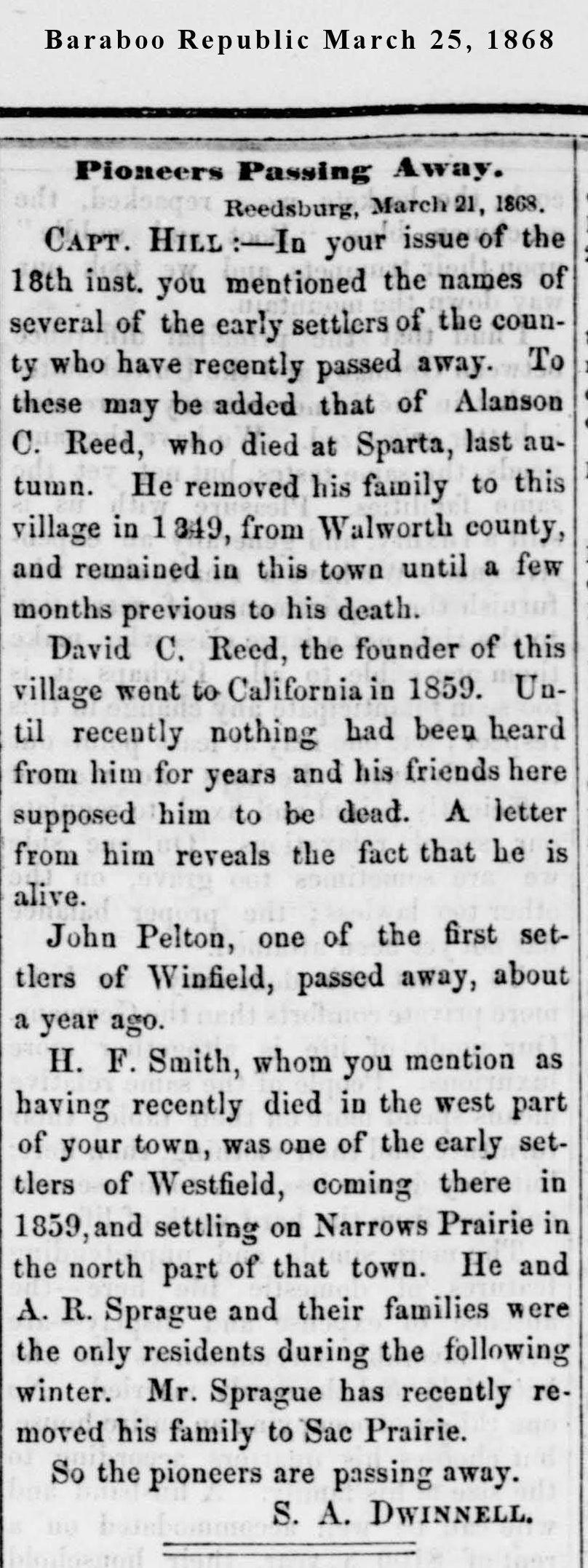

“David C. Reed, the founder of this village went to California in 1859. Until recently nothing had been heard from him for years and his friends here supposed him to be dead. A letter from him reveals the fact that he is alive.” Excerpt from the left column.
The article on the left from 1868, illuminates the fact that David C. Reed, went to California in 1859, and had sent a letter to Reedsburg that he was indeed, still alive.
For many years, historians have wondered what happened to Reedsburg’s founder, David C. Reed after he left this area to seek his fortune in the gold fields of Pikes Peak in 1859.
In 1996 the search to find out more about him intensified and led to new information. A description of Reed was found in Merton Krug’s book and names of his sons were on the 1850 census. The story unfolds...
“He was a tall, slender gentleman with graying hair, very pleasant looking, and with always a twinkle in his blue eyes, always jolly and friendly.” A Portrait in Words by Mrs. Cynthia Reed, wife of George Hamilton Irwin Reed.
David Coldwell Reed was born about 1808 of Welsh descent. His place of birth and direct parentage are obscure. Since he is to have said that he was brought up by a Baptist minister, his mother may have died when he was very young.
David C. Reed, Joseph Reed, Adam Reed and Alanson Reed all lived in separate households in Cairo, Greene County, New York in 1830. Alanson, a known first cousin of David, is the son of Adam Reed. It can be speculated that David is the son of Joseph Reed, but confirmation is still needed.
The 1840 federal census of Broome Township, Schoharie County, New York lists David C. Reed, his wife, two males under five years and three other people, probably siblings, hired help or boarders. First names are not given.
David C. Reed had married Loretta Dixon, the daughter of Joseph and Abigail Dixon, and did have two sons by then. The oldest, Levi was born in 1837, George Dixon Reed on August 17, 1838, and Harrison in 1841, all in New York.
In the early 1840’s David became restless and embarked upon the trail west to Wisconsin. First, he bought land in Walworth and Sharon Townships in Walworth County, Wisconsin. They lived in Big Foot Prairie near the Illinois border. On June 1, 1846, David C. Reed was living in Sharon Township. Walworth County, Wisconsin. The family consisted of five males and one female. That is where the youngest son, Charles F. was born on June 18, l846.
Loretta Dixon Reed, David’s wife, died September 10, 1846, age 36 years and l5 days. She is buried in Big Foot Cemetery on Highway l4 about three miles south of Walworth, Wisconsin.


There could have been one older son who died in 1834 in New York. Joseph Mackey, born in 1822, whose mother was a Dixon, said that at age twelve he went to live with David Reed, who had just lost a son. (Reedsburg Intensive Survey, 1984)
David C Reed came to Reedsburg in 1847. By 1849 the four sons were living in Reedsburg with their father in the Mill House, which had been built by Austin Seeley and then enlarged. Anna R. Wheeler (widow of Resolved Grosvenor Wheeler, nee Van Deventer) was a member of the Reed household, but she is not known to be a relative. Only Charles was still here in 1860. The two older brothers, Levi and George, were still in Reedsburg for the 1855 State Census and traveled west about 1858. Levi was living
in Oregon Territory in 1860 in close proximity to his brother George. David was not with them. Ten years later L.S. and G.D. Reed were enumerated in Ada County, Idaho Territory.
Levi married Mary E. Smith March 17, 1879 in Ada County, Idaho Territory. Later Levi went to Alaska looking for gold. He died in Seattle, Washington and his unclaimed estate of $80,000 reverted to the state. No descendants are known.
An item of interest regarding Levi was found in a letter to the Old Settlers in February 1922. W.I. Carver wrote “I remember attending that school (taught by Rollo Strong) for Lee Reed and myself each got a spanking on the bare hand for not declaiming when it was our orders to Mr. Carver said that at the time Horace Croswell was School Superintendent (of the town).
George D. “Loke” Reed acted as scout on a wagon train while he was still in his teens. His grandson, Hubert S. Reed, who lived in Mesa, AZ, [when this was written in 1997. He died in Sept. 2000.] recalls hearing this story about the expedition. George rode too far ahead of the wagons and all at once found himself surrounded by Indians. Would they be friendly? He did have contact with Indians while he lived in
Reedsburg, so he was hopeful. The Indians took him to their campsite and seemed friendly enough when they offered him a meal. George was to have stewed crickets and roast dog, and he did! After eating and then smoking the peace pipe with them, he was let go.
George Dixon Reed married Sarah Ellen Johnson June 25. 1871, lived in Idaho and had nine children. Two died young. Besides grandson, Hubert S. “Curly” Reed, who has been doing research since the 1950s. Carolyn Brower is a great granddaughter of George Reed and is also a dedicated genealogist.
George D. Reed died September 2, 1929 at Mountain Home, Elmore County, Idaho. His occupations had been prospector, dance hall owner, fiddler in a mining camp and farmer.
No trace has been found on censuses of Harrison Reed after he left Reedsburg. Charles, in an unfinished letter to “Loke” in 1866, said he hadn’t heard from Harrison in some time, but the last time he did, his brother was in Indiana. No mention was made in the letter about their father and Harrison was not found in Indiana in the 1860 census index there.


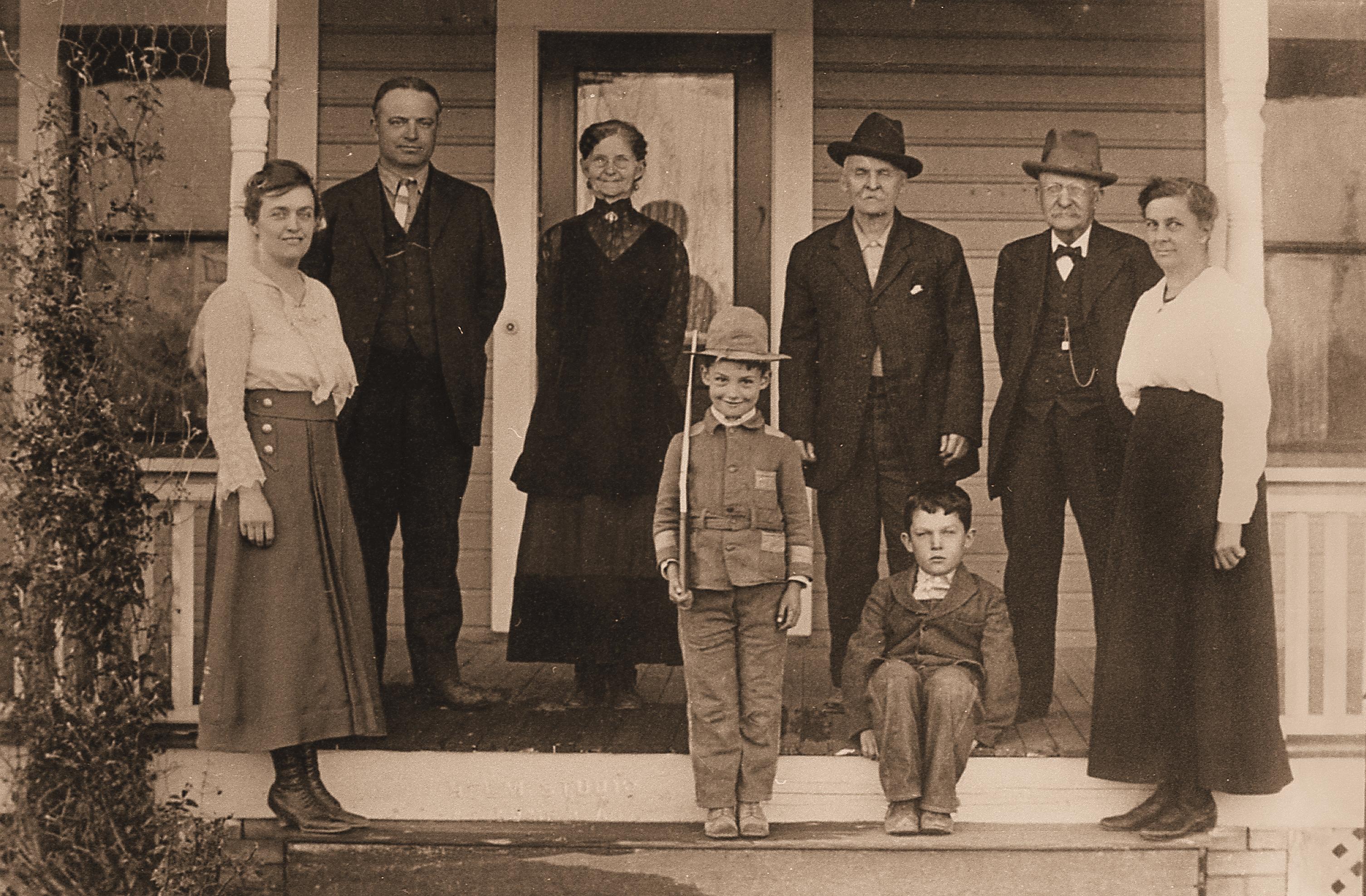

L-R: Ora (Reed) Cannon; Oscar Cannon, her husband; Sara Ellen (Johnson) Reed; George D. Reed, her husband, son of David C. Reed; Charles F. Reed, son of David C. Reed, unidentified woman. Children are Leland & Edward Cannon, sons of Oscar and Ora. Leland Cannon was the father of Carolyn Brower. 1917 photo.
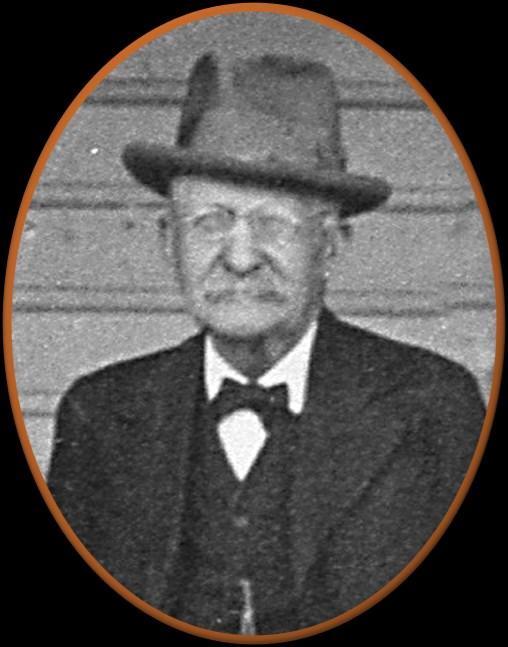








L
GOLD! Gold discovered at Pike’s Peak in Western Kansas! Fortune seekers from across the nation head west! Those, and similar headlines reverberated across the nation in 1858.
Gold fever also ran rampant in Sauk County, and many restless enraptures packed up their belongings and headed to the gold fields. It had been only ten years since most pioneers settled in the Sauk County area, and now many were on the move again, to seek their fortunes over the western horizon. The allure of vast riches must have jaded the minds of many of these erstwhile travelers as they sought that which they had not found among the green hills of south central Wisconsin. The journey was long, hazardous, and fraught with unknowns.
In the April 7, 1859 issue of the Baraboo Republic, a letter from Reedsburg recounts the excitement and adventure which the travelers anticipated.
“A company of twelve have left here today for the gold fields of Western Kansas, among them David C. Reed Esq., the founder of the village, and James Coughran of the steam mill. Eight of our citizens left for the same destination several weeks since, and a few more are expected soon to follow. Some eight or ten are soon to leave the village of Ironton for the same object.
“Many of these are among our stable citizens and several of them farmers. They are not greatly elated with imaginary visions of gold, but look at the matter in a serious and calculating mood. They are not expecting great wealth with a small outlay, but hope by patient toil and rigid economy, to obtain in the course of the coming year or two that which will enable them to place their families in circumstances of comfort, which they fear that they shall not be able to do otherwise. May their hopes be realized.”
David Caldwell Reed, pioneer settler and namesake of the city of Reedsburg, WI, came to Sauk County in 1847 and settled along the Baraboo River. He was born in New York around 1808. He married Loretta
Dixon ca. 1830, and they had four sons, Levi S., George D., Harrison and Charles F. David’s wife had passed away in 1846 at 36 years of age, in Walworth County, where they originally settled before coming to what was to become Reedsburg.
The Pike’s Peakers traveled by water, via the Baraboo, Wisconsin, Mississippi and Missouri Rivers. Forty-eight men had left the area by the end of April, 1859.
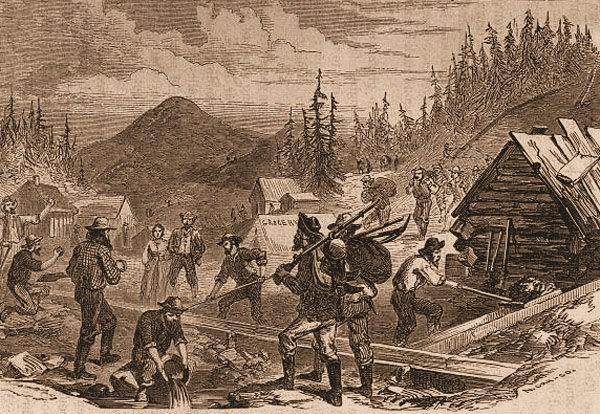

But, alas, all was not as anticipated. By the end of May of that same year, another letter in the Baraboo Republic, from Henry Gitchell of Baraboo, who had just returned from his western trek, sadly bemoaned the fact that he had gone as far as Ft. Kearney, Nebraska, and became satisfied that the gold stories were a cruel hoax.
“He states that he has met the greater portion of those who started from this neighborhood, and that they are now on their way home, wiser and better men, though considerably reduced in purse. It is universally conceded that the Kansas gold mines are a humbug of the ‘first water.’ The St. Louis papers, which have, probably, more than all others combined, acted to deceive the public, though perhaps they were themselves the dupes of their correspondents, have at last acknowledged the mighty humbug.”
There was gold to be found at Pike’s Peak, and those who arrived early on, scooped up all the placer (surface) gold. After that played out, the exodus commenced. Those who remained, found the real riches when they dug deeper mines into the hillsides.
Another area paper reported that some twenty thousand “enraged and desperate miners” were on their way east, “…and being in a starving condition had attacked trains going west with food, in which skirmishes several lives had been lost.”
Another letter to the Elkhorn River, WI, newspaper from a man headed west, reported on what he called the “Tide of Eastern Emigration.” The writer noted that, “They came on foot, on horse-back, with oxen and horses, scattered along like sheep without a shepherd. The reports are almost all the same, ‘Pike’s Peak is an unmitigated humbug’. Everybody says it everybody hears it everybody knows it!”
He goes on to write, “Above me on the Platt [Platte River, Nebraska] all is commotion, and from there onward to the mines, revolvers and knives are used freely.”
Other reports from the “front” accused postmasters of altering letters home to indicate that the mines were lucrative, and telling friends and relatives to leave immediately for the gold fields. It apparently being a veiled attempt to attract more settlers to the western states.
The writer concludes his letter with these ominous words, “We hear nothing good on this side of the Missouri [River]. It is said that all are coming back [east] or going through to California.”
But what of Reedsburg’s namesake, David Reed? What became of him? Searches of Reedsburg and Baraboo newspapers of the 1860 era, produced nothing. Not a single word about the whereabouts of Mr. Reed, or what may have happened to him. Was he killed in one of the skirmishes previously mentioned? Or had he continued on further west as others had?
Additional research was needed. Several historical societies in the Pike’s Peak region were contacted. Perhaps Reed had taken out a mining claim. No luck. A check of the Colorado Voters for the 1861 Territorial Election for a delegate to the 37th Congress
scored a hit D.C. Reed was listed. But was it our D.C. Reed? There was no way of knowing, so at this point the trail went cold.
Over half a century later, at a 1919 Reedsburg Old Settlers’ meeting, the secretary’s minute book reported that President John Stone gave a little sketch of the life of David Reed, and noted “…his sad death and unknown grave.” Unfortunately, that speech was never written down! So we are only left with the haunting statement, “His sad death and unknown grave.”
A letter home from a Wisconsin native indicated that some of the miners continued their journey west to California, perhaps determined to strike it rich in the gold fields of California as the forty-niners had.
There are now new venues through which a more detailed genealogical search may be conducted. Every year, additional census records are being posted on the Internet, along with birth, marriage and death records. Genealogical research organizations such as Ancestory.com, have aided countless family history buffs find long-lost ancestors and grow additional branches onto their family trees.
The next stop was Ancestory.com, and I posted David’s name again. But this time, I was the one who struck gold! About a dozen returns came up on the screen. As each was investigated, it appeared that I was on the right track. Perhaps he had not died in a skirmish in Kansas Territory, but had actually gone on to California.
Additional research in 2024, found an article in the Baraboo News for March 25, 1868, under the heading of “Pioneers Passing Away.” The following paragraph was included: “David C. Reed, the founder of this village went to California in 1859. Until recently nothing had been heard from him for years and his friends here supposed him to be dead. A letter from him reveals the fact that he is alive.”
Unfortunately, that letter has never been found.
Also, in 2024, David’s trail to California was reestablished in a list of travelers who plied the Oregon Trail. See the following pages.
New information has been discovered in 2024, which illuminates the trail which led David Reed, and his oldest son, Levi, to the western shores.
It is unknown what mode of travel the fortuneseekers took, but they undoubtedly joined a wagon train which was headed in that direction. The railroad had not entered the picture until 1871.
David and Levi Reed are next mentioned along with other travelers in an 1858 letter attesting to the quality of the trail to Fort Hall, Bannock, Idaho. The publication in which this information was found is, 1House of Representatives, 36th Congress, Doc. # 36, 1861.
This was an effort to convince the powers in Washington D.C. to improve the trail going West.
1Fort Hall, Oregon Territory, July 15, 1858. This is to certify that we, the undersigned, have travelled over the Pacific wagon road, better known as Lander’s Cut – Off, and find it a very acceptable road for emigrants. We think it preferable to any other road across the mountains in many respects & most of the way it is well worked, and with a bridge across Green river (the, only stream at all troublesome & it would be as good a road as many now travelled in the States it is some five days’ travel shorter than any other road across the mountains. There is no desert to cross on this route, no alkali to kill your stock & but instead, plenty of good water, abundance of grass, and wood enough to satisfy any reasonable man. Many of the undersigned have crossed by other routes, and give this the preference.
See the following 3 pages for the Reed travelers.
The Nobles Emigrant Trail, also known as the Fort Kearney, South Pass and Honey Lake Wagon Road, is a trail in California that was used by emigrant parties from the east as a shortened route to northern California. It was pioneered in 1851 by William Nobles, who discovered an easy shortcut between the Applegate Trail in Nevada and the Lassen Trail in California. The trail was extensively used until the 1870s, when it was superseded by railroads. Wikipedia
1Additional estimate for Fort Kearney, South Pass, and Honey Lake wagon road : letter from the acting Secretary of the Interior, transmitting a communication from Colonel Lander in regard to the Fort Kearney, South Pass and Honey Lake wagon road. By United States. Dept. of the Interior; Lander, Frederick West, 1821-1862
“
Another signed statement by emigrants who used the trail on October 25, 1859.
We, the undersigned, emigrants to California and Oregon, having just passed with our wagons and stock over the new government road from the South Pass to Fort Hall, (called Lander’s Cut – Off) do hereby state that the road is abundantly furnished with good grass, water, and fuel there is no alkali and no desert, as upon the old road, and while upon it our stock improved and rapidly recovered from sickness and lameness. We were much surprised at the great amount of labor that had been done in cutting out the timber and bridging and grading the road, and in all respects it more than met our expectations, especially those of us who have heretofore travelled the other routes. But we would most respectfully suggest that a bridge should be erected, as soon as possible, over Green river, the fording of which is dangerous and the cause of much trouble to the emigration, and in one instance the loss of life. We have been treated kindly and, in every case where the circumstances required it, aided and assisted on our way by the wagon road expedition, and we have likewise received the kindest treatment from the Indians, and we advise the overland emigration to California and Oregon to take this road, as the shortest and best adapted for the comforts of the traveler and the preservation of stock , especially if the government, in view of the many advantages of this route, should cause Green river to be bridged.”
1Statement of emigrants to Oregon and California.



Wagner, W H. Preliminary Map of the Central Division
Ft. Kearney South Pass & Honey Lake Wagon Road.
Philadelphia: T.S. Wagner's Lith, 1858.
The eastern part of the Oregon Trail spanned part of what is now the state of Kansas and nearly all of what are now the states of Nebraska and Wyoming. The western half of the trail spanned most of the current states of Idaho and Oregon.

From an 1859 open letter to Washington, attesting to the fact that the pioneer trail was acceptable to the travelers headed West. It was signed by David and Levi Reed, along with several other Reedsburg travelers

##The Reedsburg travelers who took the “Wagon Road” when they were headed West.

Additional estimate for Fort Kearney, South Pass, and Honey Lake wagon road : letter from the acting Secretary of the Interior, transmitting a communication from Colonel Lander in regard to the Fort Kearney,SouthPassandHoneyLake wagon road. By United States. Dept. of the Interior; Lander, Frederick West,1821-1862
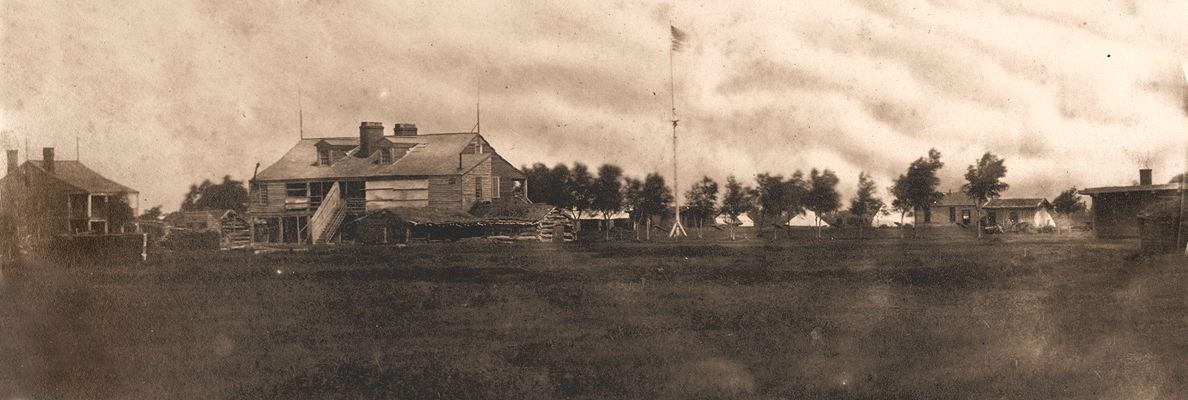

Fort Kearney, Idaho, as it looked in 1858, when the Reedsburg travelers would have passed through there on their journey West.
Source: Samuel C. Mills - photographer with the Simpson Expedition, Library of Congress.


Sharp Creek Meadow, as it looks today. Remnants of the trail West over which David and Levi Reed would have traversed when traveling to California. The wagon wheel ruts are still visible.
Lander Trail near Sharp Creek meadow, looking southeast toward South Pass and Oregon Buttes. Will Bagley photo.
The first record of a David C. Reed’s presence in California, indicated that he had fallen on hard times. On January 5, 1865, he had been arrested and committed to an insane asylum in Stockton, CA.
The hospital committal record for that date stated David C. Reed: “Age about 52 years; native of New York; was last from Wisconsin; has been in this state about five years; occupation laborer. This patient was arrested by the city police and all the above information obtained from him. His general appearance and conversation indicates insanity. He is dangerous from irregular conduct and actions; class of insanity mania.”
The age was close, he was born around 1809, the birthplace, N.Y. was right, he had lived in Wisconsin, and he had been in California about 5 years by 1865 (he disappeared from Reedsburg around 1859).
Based upon the that information, it is quite logical to assume that this was the Reed who founded the city of Reedsburg, Wisconsin. One hundred and fifty years after his disappearance from Sauk County, David Caldwell Reed had been found!


The Stockton State Hospital was founded in 1851, to accommodate “…the large numbers of people who suffered from mental and emotional conditions as a result of the California Gold Rush.”
Insanity, mania is characterized by violent, abnormal or impulsive behavior, including delusion. From the admittance description of the condition of Mr. Reed, these symptoms may have been observed by the police, thereby resulting in his arrest and committal.
.
Whatever the cause for Reed’s tenure there, he must have been deemed better seven months later by August, 1865, because he was discharged at that time, to carry on with his life.
California State Hospital Records, 1856 – 1923 for David C. Reed
Stockton State Hospital Commitment Registers, Vol. 03-04, 1862-1870 Page 187
David C. Reed
Committed by Robert C. Cla___, Judge of Sacramento County, January 5, 1865.
Age about 52 years; native of New York; was last from Wisconsin; has been in this state about five years; occupation laborer. This patient was arrested by the city police and all the above information obtained from him. His general appearance and conversation indicates insanity. He is dangerous from irregular conduct and actions; class of insanity mania. The patient is a s_____ (undecipherable) consequently all the questions are unanswered.
Admitted January 8, 1865
Discharged August 11, 1865
In October, 1853, a letter appeared in the Sauk County Standard, outlining the feasibility of establishing a railroad line through Reedsburg. David C. Reed was one of the signatories of that correspondence.
The writers of that letter, laid out the exact route which could be taken from Portage, through Baraboo, and then on to Reedsburg. In great detail, they described the land and rivers which would be crossed and exactly the method of executing that endeavor.
“Gents: Understanding that a doubt existed in the mind of the people of the county of Sauk, relative to the feasibility of a route for the La Crosse and Milwaukee R Road, we would say, that we have just returned from a thorough examination of the proposed route, and fine it as follows…” A detailed description is then provided as to how the feat could be accomplished. Obviously, this never came to pass. The railroad did eventually come to Reedsburg, but not until 1872.





1850 Census Baraboo, WI Township David C. Reed, Dwelling 717, Age 42, Occupation: none,
Value of estate: $10,000, Born: N.Y.
Other residents: Levi, 13; George, 12; Harrison, 9; Charles, 4; A.R. Wheeler, 65, female.
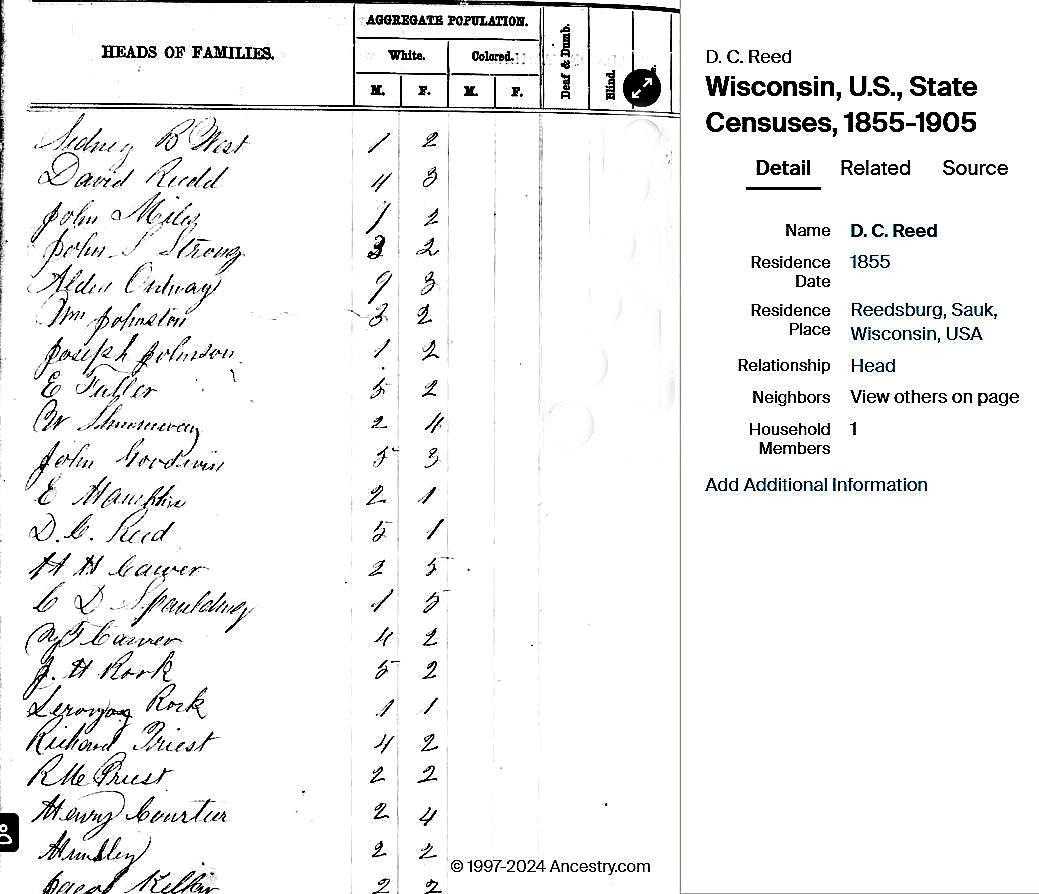



1870 Agriculture Census
David C. Reed Agricultural Census from Santa Cruz, California. This indicates that David C. Reed had 2 horses, 1 milk cow, 25 swine, value of all his stock, $300 ($7,000 in today’s dollars).


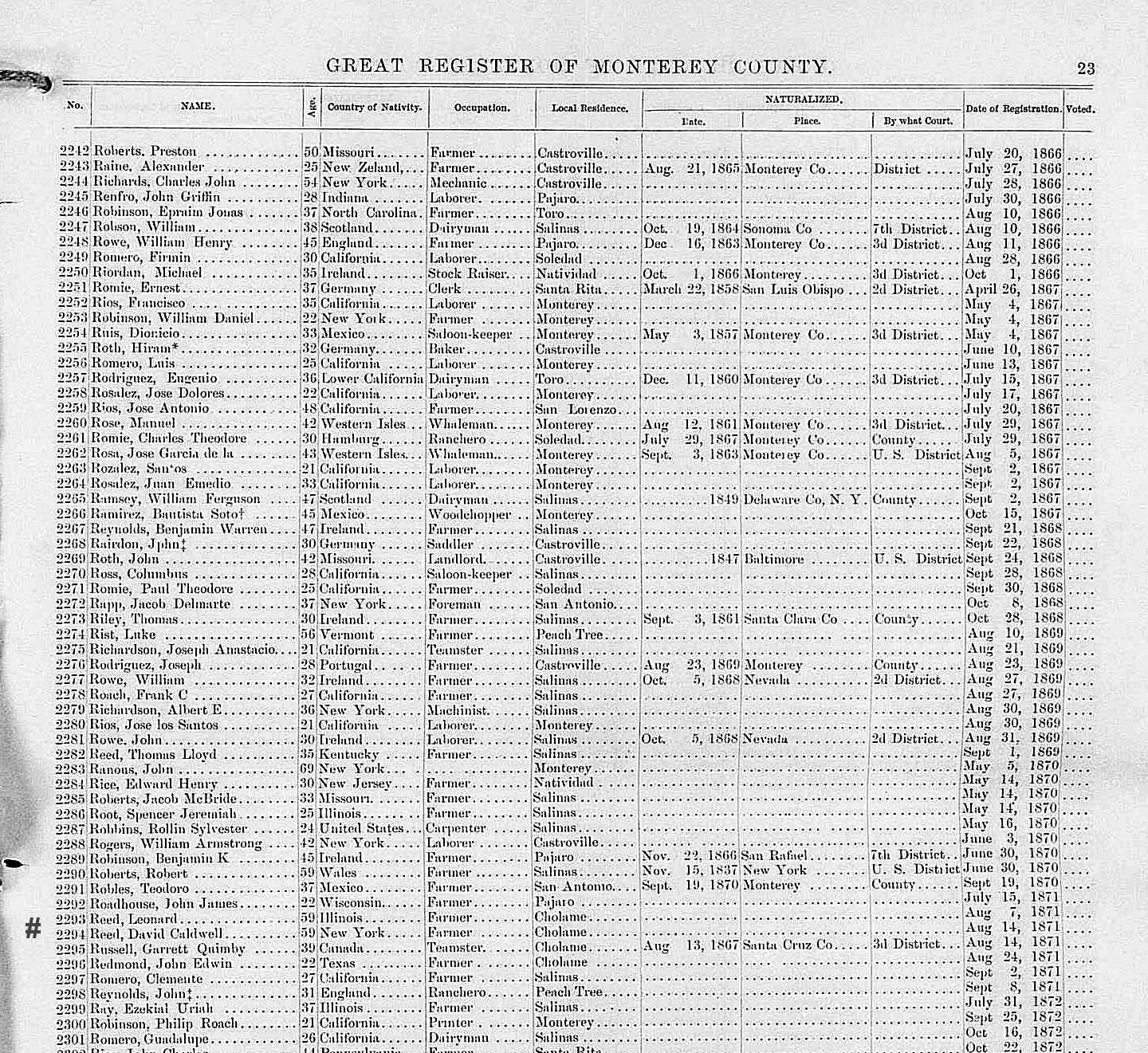
The above document is the last verifiable record for David Caldwell Reed that has been located. There were other persons with the names of David Reed, David C. Reed, even David Caldwell Reed found in California, however, there are things such as birth dates, ages, registration dates, etc. that do not match our Reed. The records, such as the one above, have been transcribed from the original documents, and there may be errors in the transcriptions. I have not been able to locate an 1875 California State
And, I have not been able to locate him on the 1880 California census.
So, as of March, 2024, that is as far as I have been able to trace our David Caldwell Reed.


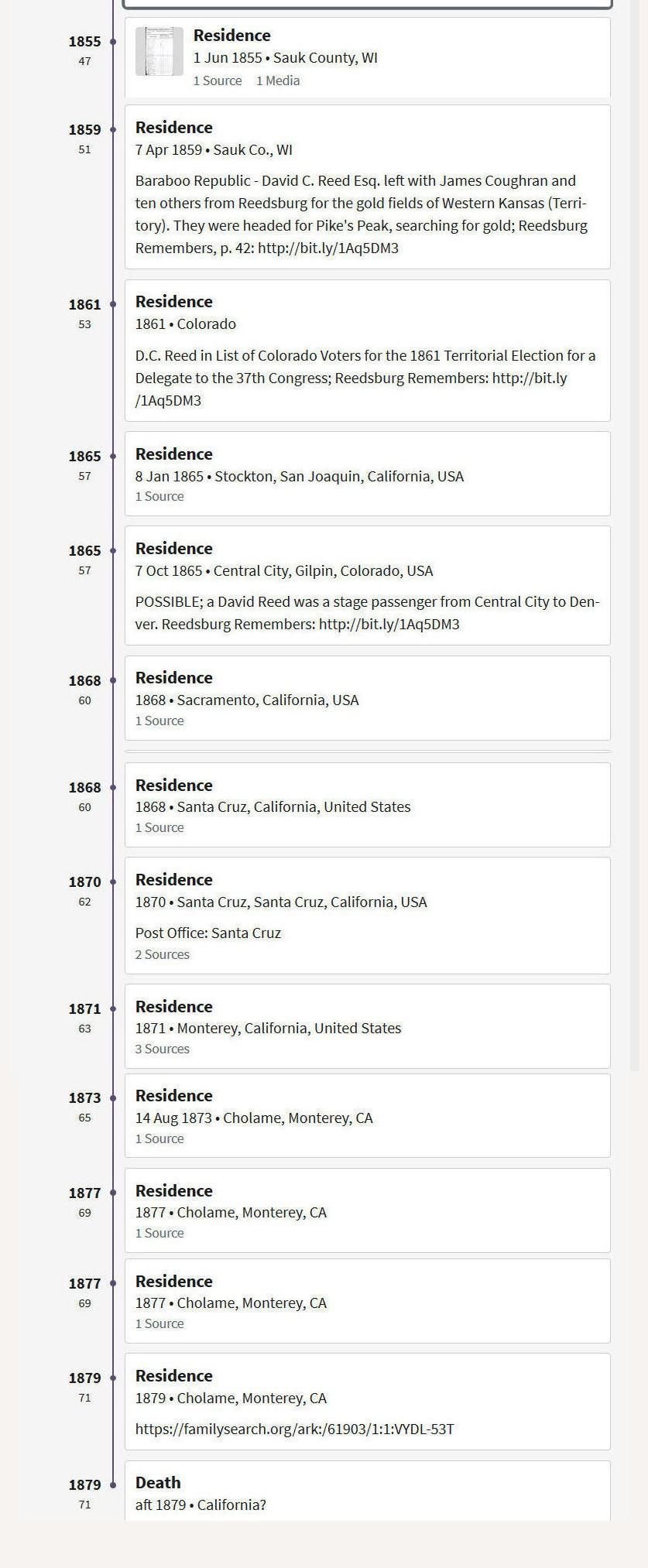 Julie Prentis Watts Chronology
Julie Prentis Watts Chronology

The information contained in this chronology, may have errors. Future research will be needed to guarantee its accuracy.
*I cannot positively verify any of the dates beyond 1871. There are too many inconsistencies in those records.
1837- ?
First son of David Caldwell Reed


The two older brothers, Levi and George, were still in Reedsburg for the 1855 State Census and traveled west about 1858. Levi was living in Oregon Territory in 1860 in close proximity to his brother George. David was not with them. Ten years later L.S. and G.D. Reed were enumerated in Ada County, Idaho Territory. Levi married Mary E. Smith March 17, 1879 in Ada County, Idaho Territory. Later Levi went to Alaska looking for gold. He died in Seattle, Washington with an unclaimed estate of $80,000 ($2,400,000 today). It’s possible that he struck it rich in the Alaska gold fields.
1837- ?
First son of David Caldwell Reed


1837- ?
First son of David Caldwell Reed
1880 Federal Census


See previous page for details.
17Aug 1838 2 Sep 1929
Second son of David Caldwell Reed





17Aug 1838 2 Sep 1929
Second son of David Caldwell Reed
Wife of George Dixon Reed


17Aug 1838 2 Sep 1929
Second son of David Caldwell Reed
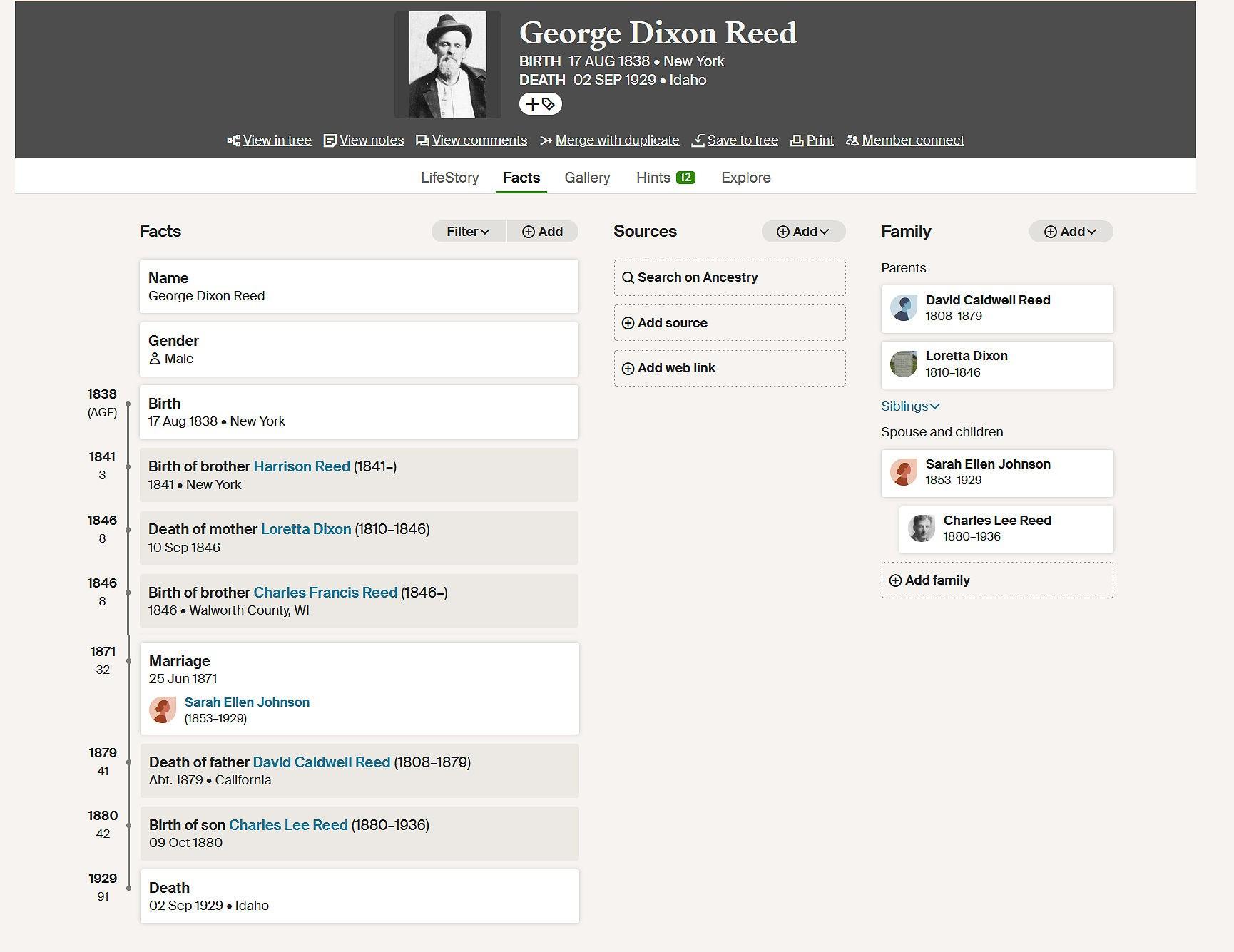

George D. “Loke” Reed acted as scout on a wagon train while he was still in his teens. His grandson, Hubert S. Reed, who lived in Mesa, AZ, [when this was written in 1997] recalls hearing this story about the expedition. George rode too far ahead of the wagons and all at once found himself surrounded by Indians. Would they be friendly? He did have contact with Indians while he lived in Reedsburg, so he was hopeful. The Indians took him to their campsite and seemed friendly enough when they offered him a meal. George was to have stewed crickets and roast dog, and he did! After eating and then smoking the peace pipe with them, he was let go.


George Dixon Reed
17Aug 1838 2 Sep 1929
Second son of David Caldwell Reed
The two older brothers, Levi and George, were still in Reedsburg for the 1855 State Census and traveled west about 1858. Levi was living in Oregon Territory in 1860 in close proximity to his brother George. David was not with them. Ten years later L.S. and G.D. Reed were enumerated in Ada County, Idaho Territory.
George D. Reed died September 2, 1929 at Mountain Home, Elmore County, Idaho. His occupations had been prospector, dance hall owner, fiddler in a mining camp and farmer.


Mountain View Cemetery
Elmore County, Idaho


1841- ?
Third son of David Caldwell Reed
1850 Federal Census




No trace has been found on censuses for Harrison Reed after he left Reedsburg. Charles, in an unfinished letter to “Loke” in 1866, said he hadn’t heard from Harrison in some time, but the last time he did, his brother was in Indiana. No mention was made in the letter about their father and Harrison was not found in Indiana in the 1860 census index there.
Charles Leroy Reed
9 Oct 1880 28 July 1936
Son of George Dixon Reed
Grandson of David Caldwell Reed


Hubert S. Reed photo
16 June 1846 15 Nov 1924
Fourth son of David Caldwell Reed




16 June 1846 15 Nov 1924
Fourth son of David Caldwell Reed
Wife of Charles Reed
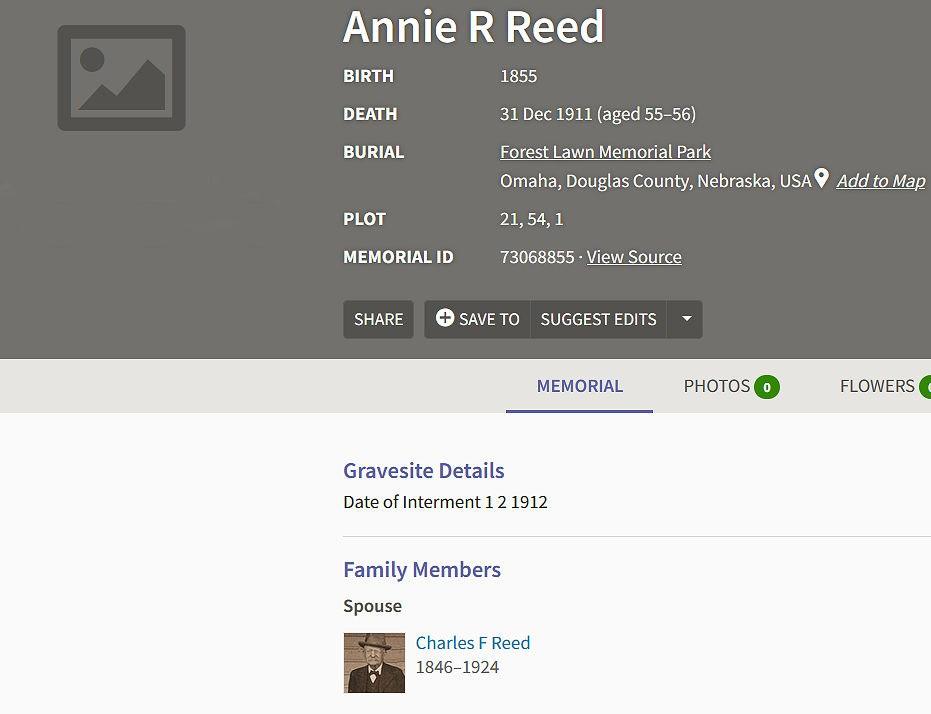



Charles Leroy Reed
9 Oct 1880 28 July 1936
Son of George Dixon Reed


Grandson of David Caldwell Reed At
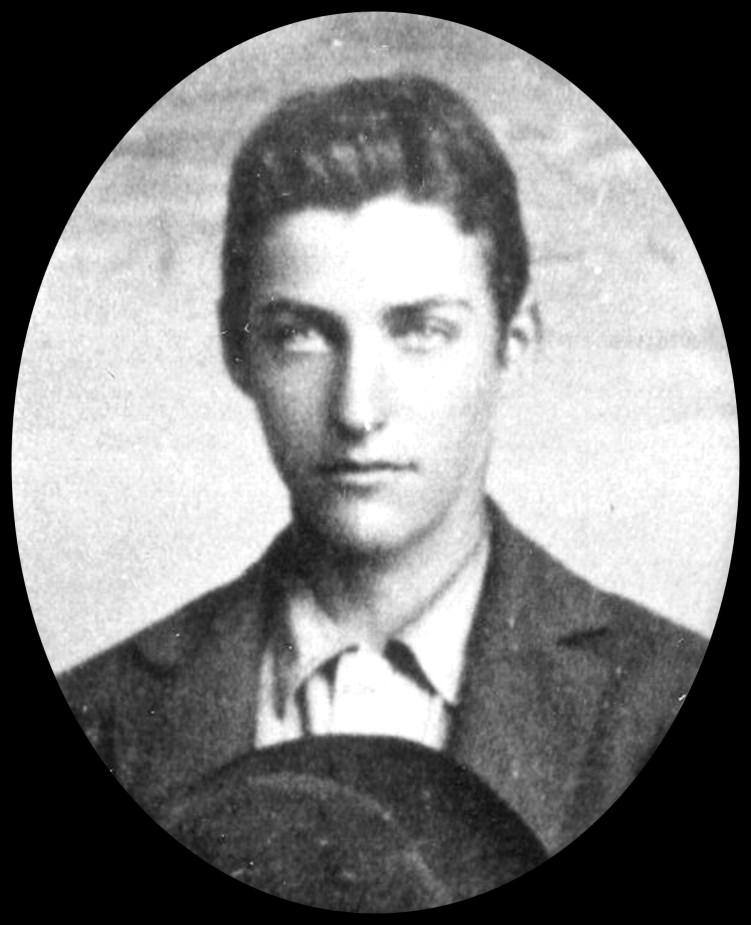
Charles Leroy Reed
9 Oct 1880 28 July 1936
Son of George Dixon Reed
Grandson of David Caldwell Reed

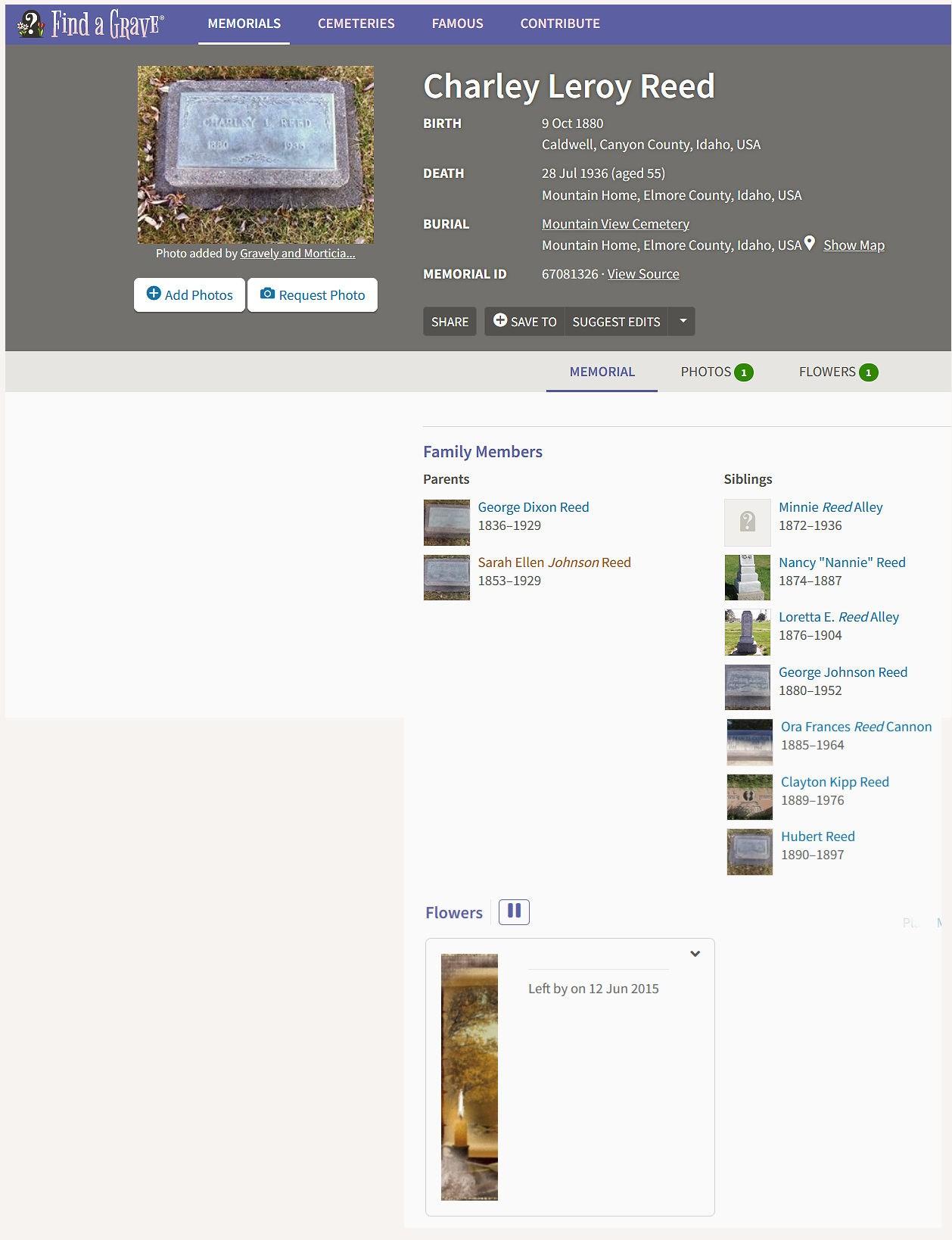


There are some errors in the above information. Brewer should be Brower.
CENSUS TAKER It was the first day of census, and all through the land; The pollster was ready ... a black book in hand. He mounted his horse for a long dusty ride; His book and some quills were tucked close by his side. A long winding ride down a road barely there; Toward the smell of fresh bread wafting, up through the air. The woman was tired, with lines on her face; And wisps of brown hair she tucked back into place. She gave him some water ... as they sat at the table; And she answered his questions ... the best she was able. He asked of her children... Yes, she had quite a few; The oldest was twenty, the youngest not two. She held up a toddler with cheeks round and red; his sister, she whispered, was napping in bed. She noted each person who lived there with pride; And she felt the faint stirrings of the wee one inside. He noted the sex, the color, the age... The marks from the quill soon filled up the page. At the number of children, she nodded her head; And saw her lips quiver for the three that were dead. The places of birth she 'never forgot'; Was it Kansas? or Utah? or Oregon ... or not? They came from Scotland, of that she was clear; But she wasn't quite sure just how long they'd been here. They spoke of employment, of schooling and such; They could read some .and write some .. though really not much. When the questions were answered, his job there was done; So he mounted his horse and he rode toward the sun. We can almost imagine his voice loud and clear; 'May God bless you all for another ten years.' Now picture a time warp ... its' now you and me; As we search for the people on our family tree. We squint at the census and scroll down so slow; As we search for that entry from long, long ago. Could they only imagine on that long ago day; That the entries they made would effect us this way? If they knew, would they wonder at the yearning we feel; And the searching that makes them so increasingly real. We can hear if we listen the words they impart; Through their blood in our veins and their voice in our heart
Author Unknown